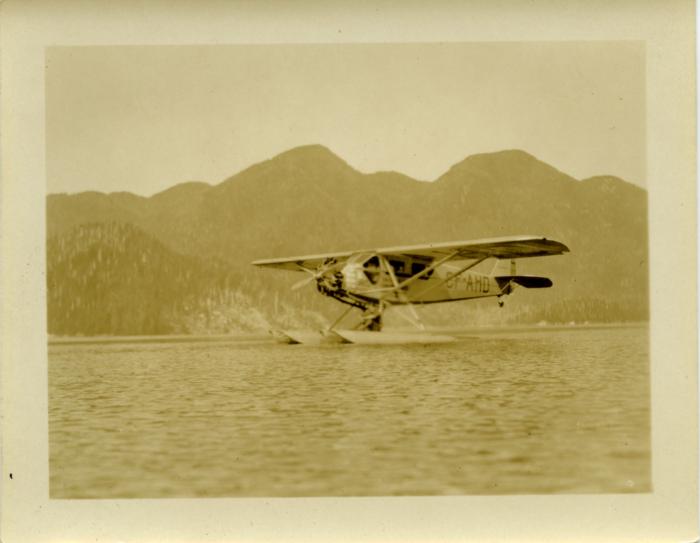Stewart Collection ➔ Photographic Print
Archival Item
2008.5.103
Black and white, sepia-toned photograph of Yukon Airways & Exploration Company Ltd. plane, Queen of the Yukon II (CF-AHD). the plane is on floats on the water, mountains are visible in the background.
The back of the photo has "3 00" stamped on it in blue ink. There is a 0.7 cm white border around the photo.
This photo is almost identical to 2008.5.72
The back of the photo has "3 00" stamped on it in blue ink. There is a 0.7 cm white border around the photo.
This photo is almost identical to 2008.5.72
Gordon Stewart joined Yukon Airways & Exploration Company Ltd. in the summer of 1929 when the company purchased a new Ryan B5, to be the Queen of the Yukon II. The plane was picked up in St. Louis, Missouri by pilot John Patterson and flown to Seattle, Washington. It was in Seattle that Gordon Stewart began his tenure with Yukon Airways. Pontoons were fitted on the plane at Renton airport and they began their barnstorming trip up the west coast of B.C. Ocean Falls was a stop along the way.
Barnstorming was often a way for pilots and airlines to finance their trips or company. The pilot would fly over a small rural town and attract the attention of the local inhabitants. The pilot would then land at a local farm (hence the name "barnstorming") and negotiate with the farmer for the use of one of his fields as a temporary runway from which to stage an air show and offer airplane rides to customers. After obtaining a base of operation, the pilot would fly back over the town, or "buzz" the village, and drop handbills offering airplane rides for a small fee, usually from one to five dollars. Crowds would then follow the airplane to the field and purchase tickets for joy rides. The locals, most of whom had never seen an airplane up close, were thrilled with the experience. For many rural towns, the appearance of a barnstormer or an aerial troop on the horizon was akin to declaring a national holiday; almost everything in the town would shut down at the spur of the moment so that people could purchase plane rides and watch the show. From Wikipedia
Barnstorming was often a way for pilots and airlines to finance their trips or company. The pilot would fly over a small rural town and attract the attention of the local inhabitants. The pilot would then land at a local farm (hence the name "barnstorming") and negotiate with the farmer for the use of one of his fields as a temporary runway from which to stage an air show and offer airplane rides to customers. After obtaining a base of operation, the pilot would fly back over the town, or "buzz" the village, and drop handbills offering airplane rides for a small fee, usually from one to five dollars. Crowds would then follow the airplane to the field and purchase tickets for joy rides. The locals, most of whom had never seen an airplane up close, were thrilled with the experience. For many rural towns, the appearance of a barnstormer or an aerial troop on the horizon was akin to declaring a national holiday; almost everything in the town would shut down at the spur of the moment so that people could purchase plane rides and watch the show. From Wikipedia
